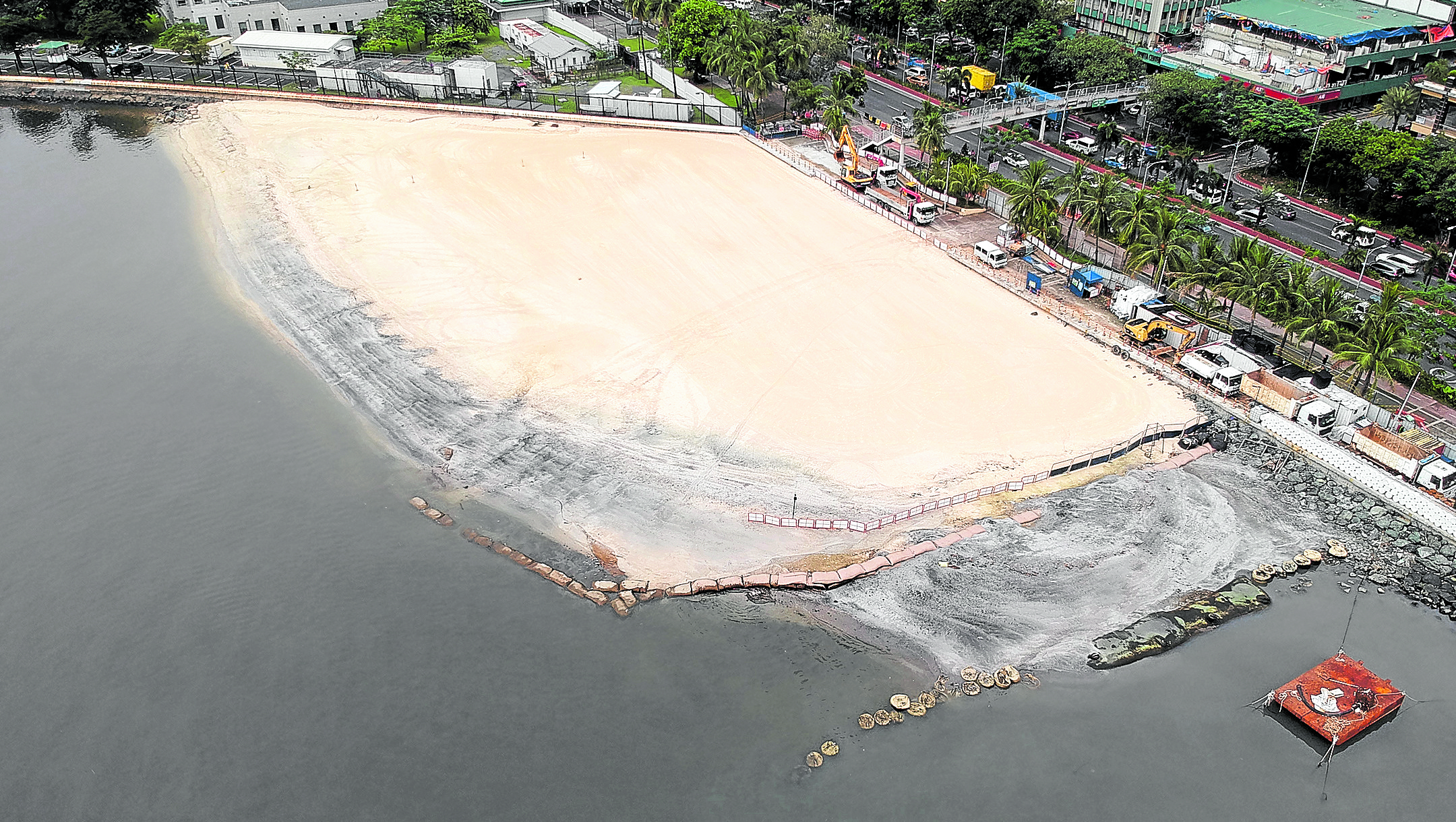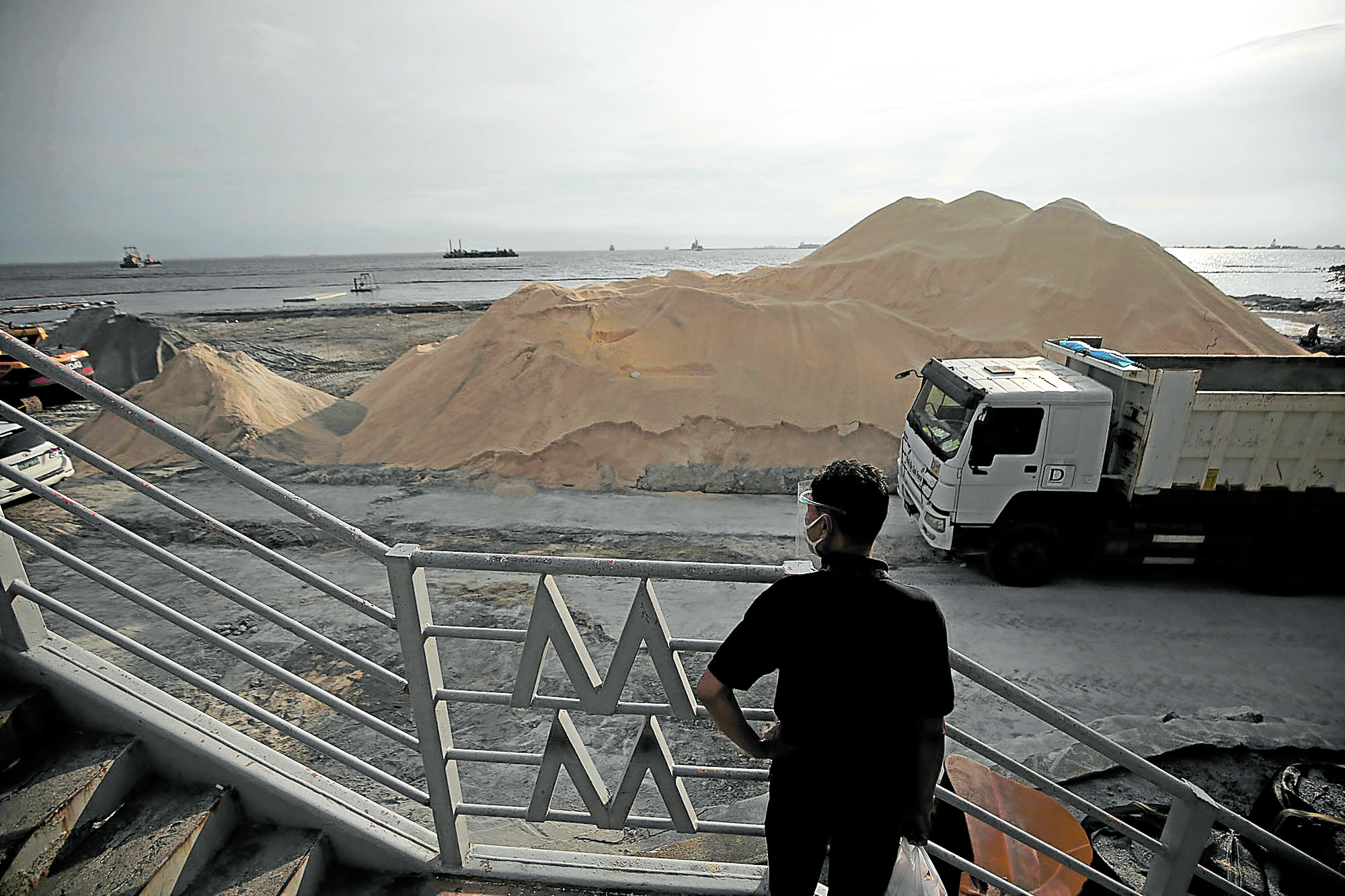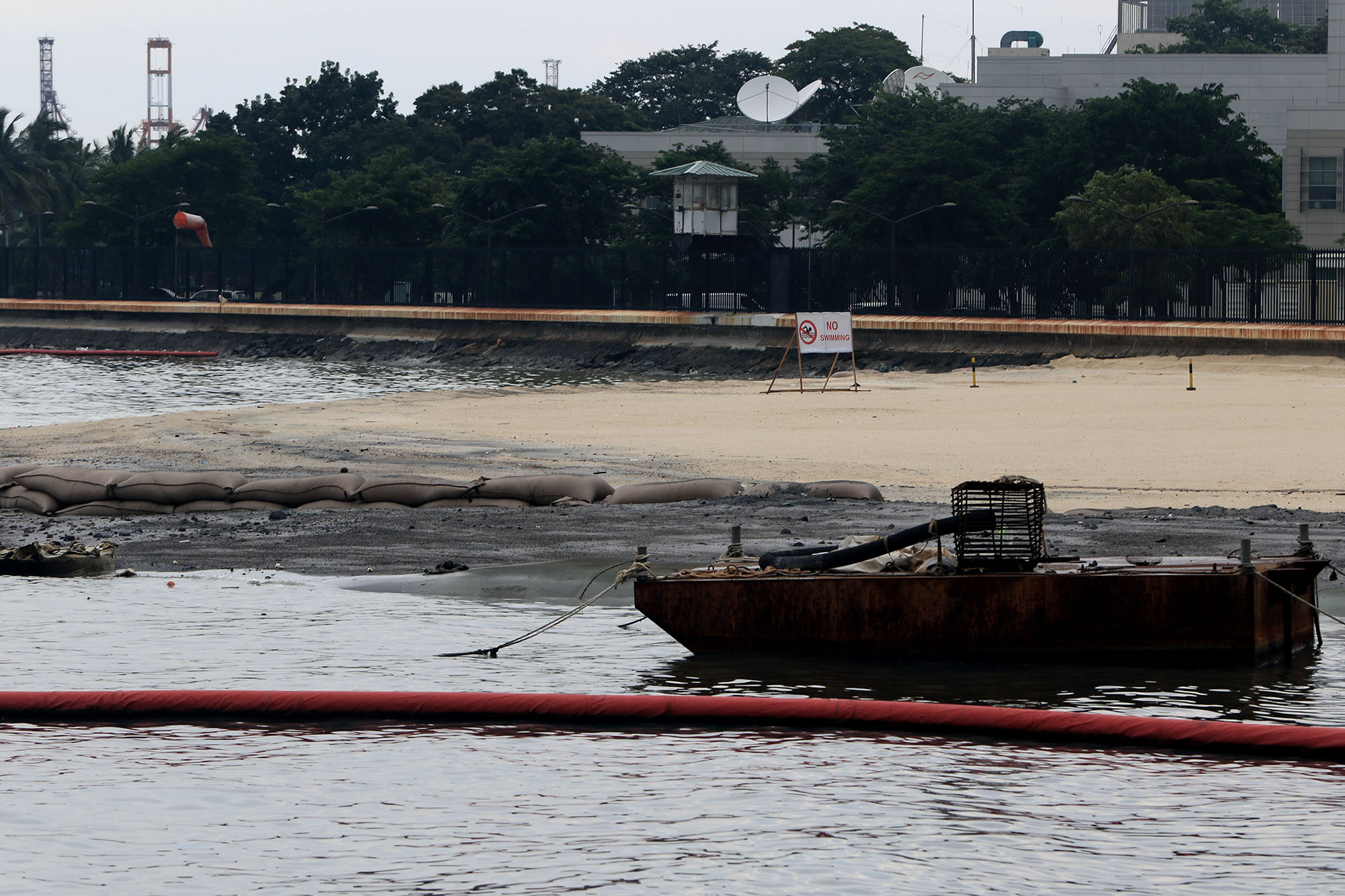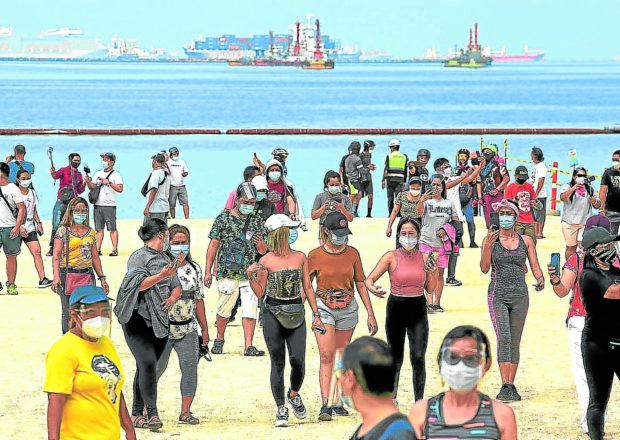The controversy that refuses to die: Manila Bay dolomite sand

Dolomite Beach along Roxas Boulevard, Manila on Friday, October 9, 2020. INQUIRER PHOTO / GRIG C. MONTEGRANDE
MANILA, Philippines — A“white sand” paradise in the heart of Manila, perhaps?
After years of being known for its polluted waters, Manila Bay suddenly got a facelift as the government decided to take a big risk by overlaying mounds of artificial white sand on a part of the bay’s naturally gray shoreline.
But this project, which is spearheaded by the Department of Environment and Natural Resources (DENR), was instantly met with harsh disapproval from environmentalists and experts alike, pointing out the dangers this may bring not only to the bay but as well as to the area where the “sand” came from.
From gray to white

TO SAVE THE BAY A 500-meter stretch of the 190-kilometer coastline of Manila Bay will be covered with sand derived from crushed dolomite in a bid by the government to beautify the scenery and encourage the public to protect it. Environmental activists are not exactly pleased. — INQUIRER FILE PHOTO / RICHARD A. REYES
With so much noise surrounding a piece of land, why is the project controversial in the first place?
The government is spending P389 million to fill Manila Bay’s gray shoreline stretching 500 meters with crushed dolomite—an anhydrous carbonate mineral composed of calcium magnesium carbonate—transported from Cebu province to Manila.
Article continues after this advertisementDuring the House deliberations for DENR’s proposed 20201 budget, Undersecretary Jonas Leones, of the DENR’s Environment and International Environment Affairs, clarified that of the P389 million, P28 million was only spent for the crushed dolomite. As for the remaining funds, this will be spent on the construction of other support structures, including “geo interventions” supposedly meant to prevent the crushed dolomite from being washed away.
Article continues after this advertisementSuch “geo interventions” include the placing of geotubes to protect the new layer of crushed dolomite from being washed away during storm surges or high tide.
Undersecretary Ernesto Adobo Jr., of the DENR’s finance, during the same hearing, said that the P389 million funding for the beautification project was derived from the “contingency fund” of President Rodrigo Duterte, and was released by the Department of Budget and Management in 2019 for the rehabilitation of Manila Bay.
“The DENR has complied with the directive to return 10 percent of our 2020 funding, which is roughly P1.069 billion, purposely to help in the COVID-19 response,” Adobo said during the House deliberation.
But before it sparked the interest of Filipinos, dolomite is already known to be used for various purposes, most commonly in the production of concrete, exterior cladding, roads, and garden paths. In fact, dolomite was also used for the construction of other man-made beaches, one of which is the popular French Riviera in the northwestern Mediterranean.
The beautification project, meanwhile, is part of the DENR’s Manila Bay Rehabilitation Program launched in January 2019, in a bid to restore the bay’s former glory after decades of pollution, in compliance with a Supreme Court 2008 ruling directing 13 agencies to clean up Manila Bay.
It was during the first week of September when the DENR started overlaying the area with crushed dolomite. From Sept. 19 to Sept. 20, the attraction was temporarily opened to the public, drawing crowds, reaching a point where quarantine protocols were ignored.
Despite the makeover, the government still prohibited spectators from swimming in the waters of Manila Bay, as that part remains polluted despite efforts to restore it.
The project somehow earned Malacañang’s praise, saying that the photo people flocking to see the “white sand” was proof that the project was a “right decision.”
“Naintindihan po natin ‘yan dahil talagang ‘yan naman po ay nagpapatunay na tama ang desisyon ng DENR at ang siyudad ng Maynila na lalo pang pagandahin ang Manila Bay,” Palace spokesman Harry Roque said in a press briefing.
(We understand that this is proof that the DENR and the City of Manila made the right decision to enhance Manila Bay.)
A day after the temporary opening, it was closed again for the continuation of the rehabilitation works.
At present, the DENR stopped putting crushed dolomite at the bay shoreline as it encountered problems with the private contractor and supplier of the crushed mineral.
The two mining companies, Dolomite Mining Corp. (DMC) and Philippine Mining Service Corp. (PMSC) were suspended after they allegedly destroyed corals in the water near the mine site.
Why the flak?

GRAY OR BLACK SAND MANILA BAY / SEPTEMBER 25, 2020 Gray or black sand are seen on the edge of white sand from crushed dolomite which was dumped at the portion of Manila Bay near beside the US Embassy in Roxas Boulevard, Manila.vINQUIRER PHOTO / RICHARD A. REYES
While the beautification project drew awe for some, it also garnered widespread criticism from civil society groups, environment watchdogs, netizens and politicians alike.
For one, several groups pointed out that dolomite does not only bring dangers to the environment, but also pose health hazards as well. At one point, even the Department of Health (DOH) warned that inhalation of fine particles of dolomite may later lead to respiratory problems, as well as other health hazards.
“‘Yung dolomite dust, it can cause respiratory issues or effects to a person. Kapag napunta sa mata, nagkakaroon ng irritation so you just have to wash it off with water,” DOH spokesperson and Undersecretary Maria Rosario Vergeire previously said in an online forum with reporters.
(If it comes in contact with the eyes, it can cause irritation so you just have to wash it off with water.)
“Kapag na-ingest ito, it can have discomfort sa gastrointestinal system natin and magkakaroon lang ng kaunting sakit ng tiyan at pagtatae,” she added.
(If this is ingested, it can have discomfort in a person’s gastrointestinal system it will cause pain and diarrhea.)
But DENR Secretary Roy Cimatu later explained that the dolomite used for the “white sand beach” was safe, citing medical studies. He also explained that the particles of the crushed dolomite was only 2 to 5 millimeters or equivalent to 2,000 to 5,000 microns or 100 times bigger than dust.
After Cimatu’s explanation, the DOH later took note of his statement and retracted its warning.
Aside from the dolomite, groups such as the Pambansang Lakas ng Kilusang Mamamalakaya ng Pilipinas (Pamalakaya) said the DENR’s project is an “artificial rehabilitation focusing on aesthetic appearance rather than addressing the environmental degradation problems.”
Another environment watchdog, Youth Strike 4 Climate Philippines, likewise slammed the plan, saying, “There are so many issues we need to FOCUS ON like the pandemic response and yet here is our government, doing this stuff.”
The Manila Bay facelift also earned the ire of some senators, such as Nancy Binay, Risa Hontiveros and Leila De Lima, calling on the DENR to stop the beautification project.
“If DENR is really concerned about the environment and the people, it is but proper for them to immediately stop the dumping of dolomite,” Binay previously said in a statement.
As for Hontiveros, she took a jab at Palace spokesman Harry Roque who claimed that the crushed dolomite would help people mentally cope with the COVID-19 pandemic.
De Lima billed the environmental agency as the “Department of Environmental Cosmetics”, and reminded the DENR that its mandate is the “rehabilitation, preservation, and protection of our environment.”
“It is not a beach resort developer,” De Lima said of the DENR.
The outcry to stop DENR’s plan was even brought to the Supreme Court, as cause-oriented group Akbayan asked the high court to cite DENR for contempt for the Manila Bay beautification project.
And as scientists from the University of the Philippines (UP) Diliman Institute of Biology also criticized the DENR for the project, they provided an alternative: instead of crushed dolomite, the government should invest in rehabilitating mangroves.
The UP scientists explained that unlike crushed dolomite, mangrove rehabilitation is a cheaper nature-based solution that can contribute in biodiversity conservation and in climate change adaptation.
“Having ecologically healthy mangroves will also help lessen heavy metal contamination, a condition that beset Manila Bay for a long time,” the group said.
They also even expressed willingness to assist the DENR in forming and implementing a “science-based” rehabilitation program, which would focus on the recovery of the bay’s biological functions and services by restoring and protecting key habitats, reducing pollution and managing invasive species.
Standing ground

PREVIEW Visitors enjoy the “white sand”—actually crushed dolomite—beach on the Manila Bay shore after it was opened to the public for one day on Sunday, September 20, 2020. INQUIRER/MARIANNE BERMUDEZ
Despite the flak the beautification has received, the DENR stood its ground and said that the program will still continue as planned.
DENR Undersecretary Benny Antiporda, who is perhaps the most vocal in defending the project, said that more crushed dolomite is needed to fill the 500-meter project area. He also assured that the next delivery of the crushed dolomite will be of no additional cost to the government.
Currently, only 120 meters of the 500 meters were filled with the “white sand.”
And as critics pointed out that the dolomite had washed out due to rains and the bay’s strong currents, Antiporda said that it was a “lie,” explaining that the fake “white sand” was covered by the thick black sand from the bay.
“Nakita po na puro kasinungalingan yung lumabas na nag-wash out yung white sand natin,” Antiporda said during a televised briefing. “Ang nangyari po talaga is wash in. Pumasok po yung itim na buhangin at pumatong sa white dolomite.”
(That claim that our white sand washed out is a lie. It was washed in. The black sand covered the white dolomite.)
To prevent the dolomite from being washed out, Leones said that aside from the geotubes, the Department of Public Works and Highways (DPWH) is planning to construct a breakwater as an additional measure to ensure that the crushed dolomite will remain intact despite the bay’s strong waves.
“In addition to the geotubes we placed, the DPWH as we have been informed, to ensure that the beach will be there and it will not be destroyed by the strong current, they plan to put a breakwater in that area, siguro malayo lang sa beach,” Leones said in a televised interview.
“Ang purpose noon is similar to the geotubes, to caution the strong waves or strong waves na papalo doon sa beach area na ‘yun,” he added.
(Its purpose is the same as that of geotubes, which is to caution the strong waves that will hit the beach area.)